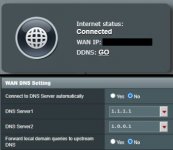If one is
only running Pi-Hole (and if using Unbound), it is way over kill to use a Pi 4 or even a Pi 3. Nothing wrong with doing so but its overkill and there are significantly cheaper Raspberry Pi device options. Pi-Hole (and Unbound) will run perfectly fine on a Pi Zero W or similar low end/older Pi's. The amount of network traffic generated by DNS requests tend to be generally very small so network speed isn't really an issue. One can run a headless Raspberry Pi Zero W powered by the Asus router's USB port and either use Zero W's integrated WiFi (minor latency issues), or use a 10/100 USB to Ethernet adapter for the Pi Zero W. There is even a way to run a Pi Zero W in Ethernet Gadget mode to run power and Ethernet over a single USB cable to an Asus-Merlin router. Some basic older directions
posted here on setting up Ethernet Gadget mode on a Pi Zero W and Asus-Merlin.
Couple of comments about setting up and using Pi-Hole with Asus-Merlin if they haven't been mentioned already. Do not use the Pi-Hole device IP address in the router's WAN DNS fields like some online directions may indicate. Doing so may cause a feedback loop with DNS requests that will flood the local network with DNS requests causing network issues. (Been there, done that.) A number of popular block lists (updated frequently) are maintained on
https://firebog.net/. There are ways to automate the updating/syncing of the FireBog.net lists on the Pi-Hole using this script:
https://github.com/jacklul/pihole-updatelists. Make sure to uncheck "Advertise router's IP in addition to user-specified DNS" in the Merlin DHCP section so the router's IP address isn't included as a DNS server which allows the bypassing of the Pi-Hole. And one can further enable the DNSFilter option in Merlin, set "Global Filter Mode" to "router", add the Pi-Hole(s) to the Client MAC Address section and set the client "Filter Mode" to "No Filtering", to force DNS requests to the Pi-Hole.





